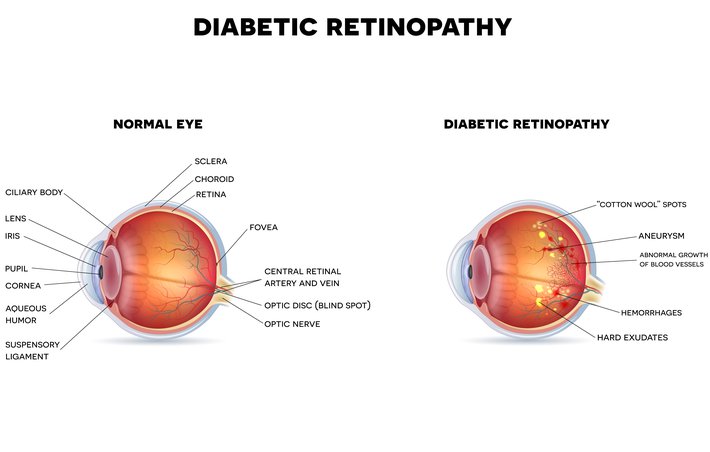General Information about Diabetic Retinopathy
Diabetic Retinopathy (DR) is the leading cause of vision deterioration and blindness across the globe. It is a complication of diabetes affecting the eyes. Among the almost 300 million people who have diabetes, about one-third of them develop DR. Read on to find out what diabetic retinopathy is, its risks and symptoms, whether it is reversible, and how to live with this disease.
Definition of Diabetic Retinopathy
Caused by diabetes, this condition appears in patients with both type 1 and type 2 diabetes. As a rule, DR occurs when the blood sugar level is too high. As a consequence of an individual’s consumption of excessive sugar and their inability to process it, the vessels become swollen and leak in the eye’s most sensitive part – the retina. Moreover, the vessels may become blocked and stop carrying blood.
Although DR starts with mild vision difficulties, over time these changes trigger eye bleed, vision loss, and even blindness. This illness is hazardous because patients may fail to detect its symptoms at the early stage of its development. Without correct treatment, one can quickly lose their eyesight.
Stages of Diabetic Retinopathy
Doctors distinguish two stages of diabetic retinopathy:
- Non-proliferative diabetic retinopathy (NPDR). This is the primary stage of the condition, which usually progresses without noticeable symptoms. Most patients with DR are diagnosed with NPDR. The blood vessels weaken and become blocked due to sugar; however, serious consequences don't appear yet. NPDR is classified into three stages: mild, moderate, and severe. In the second stage, the retina starts swelling, and it requires medical treatment. During the severe stage, the majority of the vessels in the eye are damaged.
- Proliferative stage (PDR). This is the advanced stage of DR and poses a threat to vision, and it requires professional medical treatment. As the damaged vessels do not let blood pass through, it leads to creating new, abnormal vessels. The walls of these vessels are weak, and they often bleed, triggering dark spots that can disturb or block the vision. In addition, they can cause detached retina and glaucoma.
Symptoms of DR
As we have mentioned, the symptoms of this condition are not noticeable in the early diabetic retinopathy stages, as they begin to emerge in the mild stage. A patient suffering from this illness experiences these signs:
- Blurring vision (or sudden switches from clear to indistinct vision);
- Seeing dark spots;
- Difficulty distinguishing colors;
- Poor night vision;
- Partial or full loss of vision.
These symptoms are the "red flags" of the condition. If you experience them, it means that you are in the middle or severe stages of diabetic retinopathy. We recommend taking measures to protect yourself from DR and prevent further health damage. Consume less sugar and monitor your eye health through regular medical examinations, even if your vision seems fine.
Living with DR
Some diabetic patients are at a higher risk of developing DR; for instance, poor control of blood sugar levels and a long duration of diabetes are hazardous and cause DR in more cases. In addition, having hypertension and high cholesterol contribute to the adverse effects of diabetes on the patient’s eyesight. Finally, pregnancy, tobacco use, and belonging to certain ethnic groups (e.g., African American, Hispanic, or Native American) have also proved to be associated with a greater likelihood of having DR.
If you or someone you care for has DR, do not despair. With the advancement of technologies and medicine, this condition can be treated even in its severe stages. Medical treatment can include several therapies such as laser treatment and surgery. It is also crucial to manage diabetes properly; patients should maintain a healthy diet, a regular exercise regimen, and comply with their medication regimen.
Since DR causes vision impairments, people already affected by it require part-time or full-time support in their daily activities. Dealing with their housekeeping, cooking, and traveling routines may be challenging and even dangerous once they have seriously degraded eyesight. At Buffalo Home Care, we look after elderly people and patients with different conditions. We provide a personal approach to each patient and help them to sustain a high level of quality of life. Our staff consists of reliable caregivers who are great companions for patients. We aim to help patients to achieve social wellness and provide the necessary facilities. Contact us if you want the best care for you or your elderly loved ones.
 English
English
 Spanish
Spanish


Comments